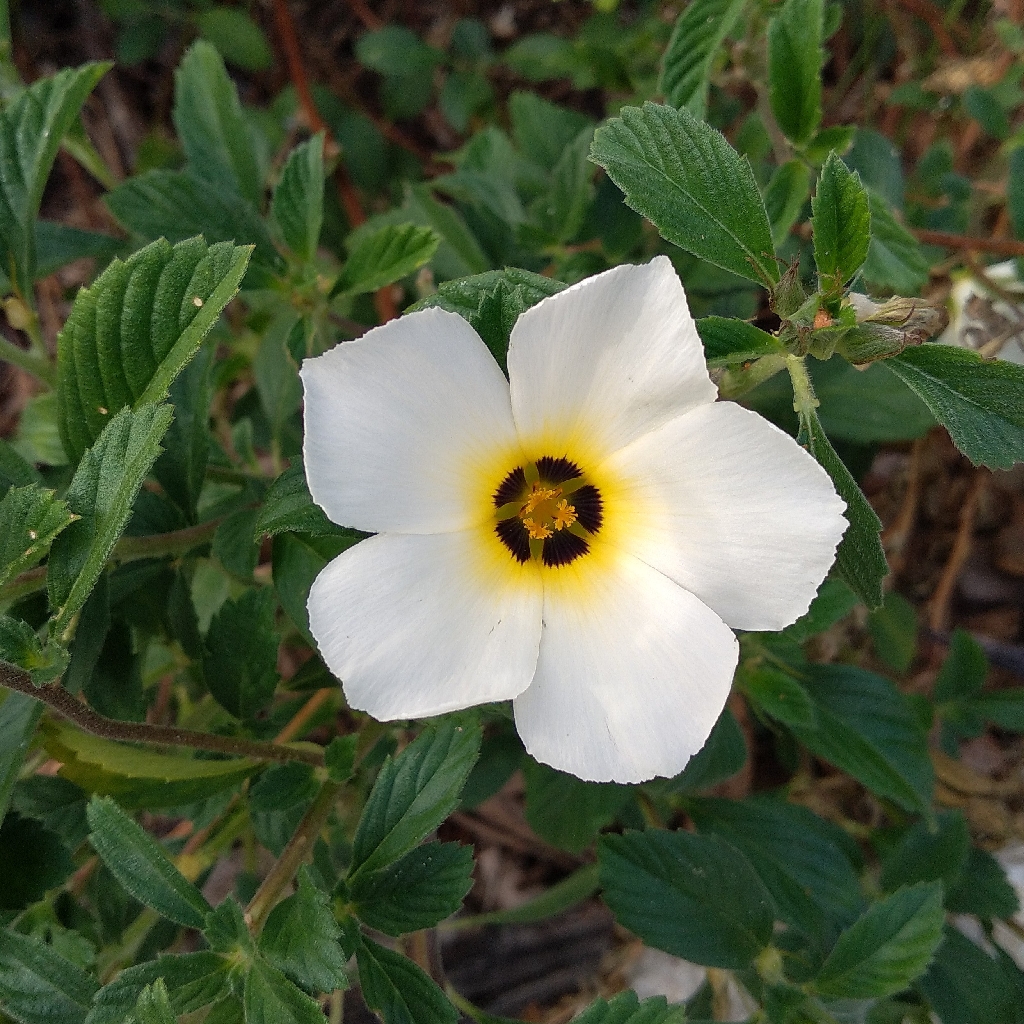
We held an Open House at our Demonstration Garden located off Harbor View Road on October 23rd. We had at least one-hundred and fourteen people attend and it was a great morning of discovery and education. One new plant that we had in the garden was unknown to me, but was catching everybody’s eyes. Someone eventually identified it as beach buttercup or Turnera ulmifolia ‘Alba’. These low-growing plants were covered in white flowers with brown and yellow throats where bees and various pollinators were busily foraging for nectar and pollen. Just like many plants, the beach buttercup comes with other common names including Cuban Buttercup, Politician’s Flower, Sulphur Alder, and White Turnera.
The beach buttercup is native to South and Central America, but it popularity as a perennial plant in warm climates has spread it to the tropical Pacific, the Caribbean and Florida. Growing to about two-foot tall with an equal spread, beach buttercups are actually in the Passionflower Family. They can make a nice low perennial shrub or a groundcover of medium height when mass planted. Mixed with other perennials and annuals, or even kept as a container plant, the beach buttercup is spectacular. Best in full sun for optimum flowering and growth, rich green, serrated foliage is topped by five-petalled, creamy-white flowers with pollinator attracting brown “eyes” in the middle. Each new flower opens at sunup and closes in early to mid-afternoon, spring through fall. While beach buttercups can get leggy with age, they can be pruned to shape and to rejuvenate older specimens.
There is another common Turnera that may be available called the yellow buttercup. This buttercup is all yellow with similar shape and attributes shared with the beach buttercup. This buttercup is mentioned in the UF/IFAS Assessment of Non-native Plants in Florida’s Natural Areas as “Caution – manage to prevent escape”, so please keep this in mind. As a general statement, Turnera will readily reseed themselves. As such, you will have a source of new plants, and the responsibility to keep any extra plants under control and in-bounds.
The beach buttercup is a great perennial for our area and is perfectly hardy in our zone. While I have seen the yellow buttercup at local garden centers, be on the lookout for the beach buttercup as well – both locally and on-line. Add new plants like buttercups to your “plant palette” to brighten up your landscape and increase its eye appeal! For more information on all types of perennials suitable for our area, or to ask a question, please visit https://www.facebook.com/CharlotteMGLifeline/ . Ralph E. Mitchell is the Director/Horticulture Agent for UF/IFAS Extension Charlotte County. He can be reached at 941-764-4344 or ralph.mitchell@charlottecountyfl.gov.
Resources:
Warner, K. (2017) Cuban Buttercup- Turnera ulmifolia. The University of Florida Extension Service, IFAS.
Turnera subulate (2021) https://en.wikipedia.org/wiki/Turnera_subulata
Goldstein, L. (2013) White Alder (Turnera subulata). Richard Lyons Nursery, Inc.
Turnera ulmifolia (2021) National Gardening Association.
Marshall, A. F. (2015) What’s Blooming in Paradise: White Alder (Turnera subulata) SANIBEL-CAPTIVA – Island Reporter, Islander and Current
Dave’s Garden. Turnera Species, Cuban Buttercup, Politician’s Flower, Sulphur Alder, White Turnera (Turnera subulate) https://davesgarden.com/guides/pf/go/2378/ .Dave’s Garden. Turnera Species, Ramgoat Dashalong, Sage Rose, Yellow Alder, Yellow Buttercups (Turnera ulmifolia) https://davesgarden.com/guides/pf/go/53526.
Jordi. R. (2010) Amelia Island Living – Cuban Buttercup, Propagating Dracaena, Shade Tolerant Grass.
- Badgett (2020) Buttercup Bush Info: Learn About Growing Turnera Buttercup Bushes. Gardening Know How.
The UF/IFAS Assessment of Non-native Plants in Florida’s Natural Areas – https://assessment.ifas.ufl.edu/assessments/turnera-ulmifolia/ – Turnera ulmifolia
 1
1
